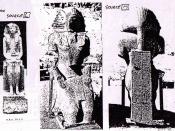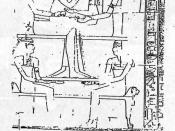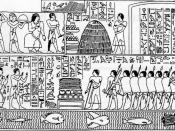In what ways did Hatshepsut portray herself as a male pharaoh?
While the concept of a female ruler as a Queen Regent or Co- regent was not foreign to New Kingdom practices there was no provision for a female pharaoh in Egyptian tradition. Hatshepsut's portrayal as male was unprecedented. 'After Hatshepsut regency for about seven years the political situation apparently changed and a bomb shell exploded'�. Hatshepsut dressed herself in the clothes of a man, put on the false beard that pharaohs traditionally wore and proclaimed her self 'king of Egypt'. Hatshepsut portrayed her self as male not only in her physical appearance. But also in her Royal title, inscriptions and in monuments.
At first during her image transformation, she was depicted with feminine facial features and a slender waist. Later she was fitted with accessories of king including a nemes headdress and symbols of Egypt's enemies inscribed beneath feet much like the seated limestone statue from Deir el Bahri.
After her image included full kingly regalia. This included the image 'wearing shendyet kilt, Nemes headdress, false beard, formal standing pose, kneeling before the gods, making offerings, depicted as a sphinx and depicted as Osiris'� e.g. red granite sphinx from Deir el Bahri.
Hatshepsut's image and titles had to be adopted to suit those of a male since a female king was unheard of which is seen in representations of her. Scribes used masculine and feminine pronouns like he/she, and masculine and feminine titles like 'her majesty and King Maat-ka-re' as they couldn't decide whether she was female or male. Titles including 'king of upper and lower Egypt' and 'mighty of kas' gave Hatshepsut a more masculine image, where over time she gained a more kingly identity. Hatshepsut strived to be remembered as a strong male pharaoh that continued...


